Abstract
In 2001’003, >60,000 km of aerial surveys and 7,700 km of vessel surveys were conducted during June to November when critically endangered Korean–Okhotsk or western gray whales (Eschrichtius robustus) were present off the northeast coast of Sakhalin Island, Russia. Results of surveys in all years indicated gray whales occurred in predominantly two areas, (1) adjacent to Piltun Bay, and (2) offshore from Chayvo Bay, hereafter referred to as the Piltun and offshore feeding areas. In the Piltun feeding area, the majority of whales were observed in waters shallower than 20 m and were distributed from several hundred meters to ∼ 5 km from the shoreline. In the offshore feeding area during all years, the distribution of gray whales extended from southwest to northeast in waters 30’5 m in depth. During all years, the distribution and abundance of whales changed in both the Piltun and offshore feeding areas, and both north–south and inshore–offshore movements were documented within and between feeding seasons. The discovery of a significant number of whales feeding in the offshore area each year was a substantial finding of this study and raises questions regarding western gray whale abundance and population levels, feeding behavior and ecology, and individual site-fidelity. Fluctuations in the number of whales observed within the Piltun and offshore feeding areas and few sightings outside of these two areas indicate that gray whales move between the Piltun and offshore feeding areas during their summer–fall feeding season. Seasonal shifts in the distribution and abundance of gray whales between and within both the Piltun and offshore feeding areas are thought, in part, to be a response to seasonal changes in the distribution and abundance of prey. However, the mechanism driving the movements of whales along the northeast coast of Sakhalin Island is likely very complex and influenced by a multitude of factors.
Keywords: Abundance, Aerial surveys, Distribution, Eschrichtius robustus, Sakhalin, Vessel surveys, Western gray whales
Introduction
There are currently two gray whale (Eschrichtius robustus) populations: Eastern Pacific (California-Chukotsk) and Western Pacific (Korea-Okhotsk). The population of western gray whales is presently estimated at approximately 123 individuals with less than 50 reproductively active adults (Yakovlev and Tyurneva 2006; Cook et al. 2006). This population was reduced by commercial whaling and until the 1970s was thought to be extinct (Brownell and Chun 1977). Western gray whales are listed in The Red Book of the Russian Federation as an endangered (category I) species and by the International Union for the Conservation of Nature and Natural Resources (IUCN) as critically endangered.
The historical distribution of gray whales in the Okhotsk Sea apparently included Sakhalinskii Bay (west of the NW end of Sakhalin Island), Akademiya, and Tugurskii bays south of the Shantarskiye Islands (in the far western Okhotsk Sea, west of the NW end of Sakhalin Island), the coastal waters of northeast Sakhalin Island, in Shelikhova, Penzhinskaya and Gizhinskaya bays in the far northeast portion of the Okhotsk Sea, and in the waters west of the Kamchatka Peninsula (Risting 1928; Krupnick 1984; Yablokov and Bogoslovskaya 1984; Perlov et al. 1996; Fig. 1). The only presently known summering and feeding area of this population of gray whales is located in the Okhotsk Sea off the northeast coast of Sakhalin Island (Blokhin et al. 1985; Berzin et al. 1988, 1990, 1991; Vladimirov 1994; Sobolevsky 2000, 2001; Blokhin and Burdin 2001; Weller et al. 1999, 2001, 2002a; Yazvenko et al. 2007a,b). Gray whales begin arriving off northeast Sakhalin Island in late May to feed, after sea ice has left the area, and some remain until late November or early December, when sea ice returns (Sobolevsky 2000; Yazvenko et al. 2007a,b).
Fig. 1.
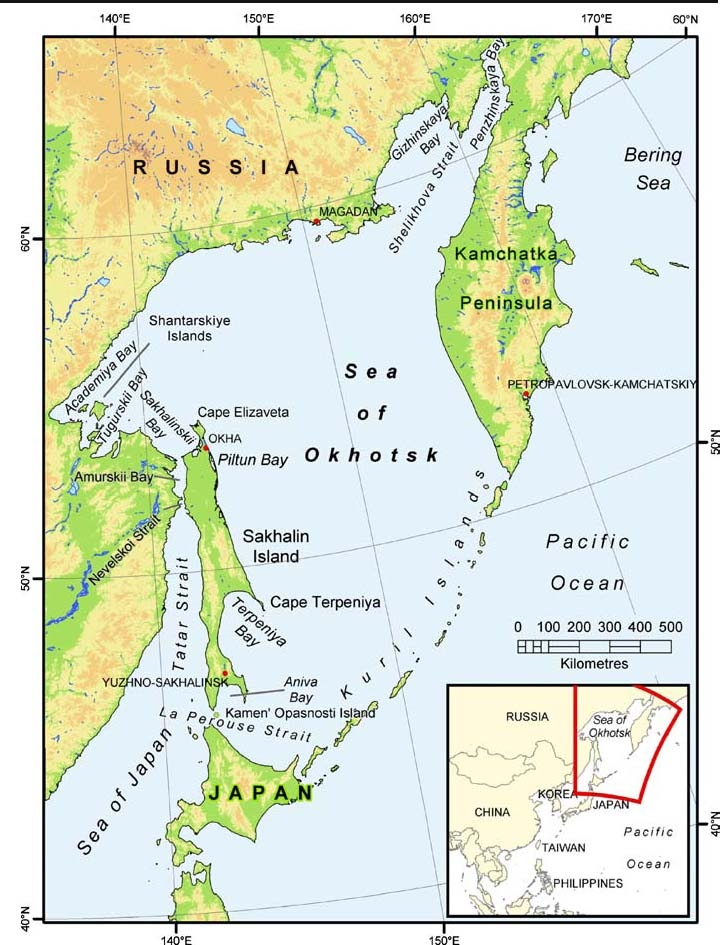
Russian Far East, Okhotsk Sea, and Sakhalin Island region, Russia
Winter calving and mating areas for this population are unknown. The long-held belief that the wintering grounds of western gray whales were along the south coast of the Korean Peninsula has not been substantiated (Rice 1998; Weller et al. 2001). Wintering grounds are now believed to be located in the South China Sea, possibly along the coast of Guangdong province and around Hainan Island (Omura 1974, 1988; Wang 1978, 1984; Rice 1998). However, specific calving and breeding sites have not been determined. Migration routes used by these gray whales are presently unknown, but it is likely that individuals migrate through La Perouse Strait (south of Sakhalin Island) then along the east coast of Sakhalin Island (Weller et al. 2001).
Exxon Neftegas Limited (ENL) and partners in the Sakhalin-1 consortium and Sakhalin Energy Investment Company (SEIC) and partners in the Sakhalin II consortium are developing oil and gas reserves on the nearshore continental shelf off northeast Sakhalin Island (Fig. 2). In 2001, a 3D seismic survey of the Odoptu license area off northeastern Sakhalin Island, Russia, was conducted by DalMorNefteGas on behalf of ENL and the Sakhalin-1 consortium during mid-August through early September. A monitoring and mitigation program was designed and implemented by ENL to reduce potential impacts of the seismic operation on western gray whales feeding in shallow (<20 m deep) waters along the coast adjacent to Piltun Bay (Johnson et al. 2007). Two components of the monitoring program were (1) replicated and systematic aerial surveys and (2) replicated and systematic vessel-based surveys carried out in the coastal area adjacent to Piltun Bay during and after the seismic survey. On 10 September 2001, approximately ten actively feeding gray whales were discovered by one of the seismic support vessels 25–30 km offshore of Chayvo Bay at 52°00′N and 143°35′E (Maminov and Yakovlev 2002) in waters 25–40 m deep. Previous to this discovery, western gray whales had only been observed feeding along the coast adjacent to Piltun Bay (Berzin et al. 1988, 1990, 1991; Sobolevsky 2000, 2001; Weller et al. 2000, 2001), in the Piltun feeding area. There had been a small number of opportunistic observations of western gray whales in this offshore area in previous years (V. Vladimirov, personal communication; E. Sobolevsky, personal communication; Miyashita et al. 2001), however these observations were never fully explored via dedicated vessel or aerial surveys. In response to the gray whale sightings in this offshore area on 10 September 2001, vessel and aerial surveys were conducted by ENL from 11–18 September 2001 to document the distribution and abundance of feeding gray whales in this offshore area. In 2002 and 2003, as part of their western gray whale monitoring program ENL and SEIC have supported vessel and aerial surveys along the northeast coast of Sakhalin Island, including both the Piltun and newly discovered offshore feeding areas. Therefore, the objectives of the aerial and vessel surveys were:
2001: Help plan the location of seismic data acquisition each day and monitor the distribution and abundance of gray whales before, during and after the seismic survey
2002 and 2003: Monitor the distribution and abundance of gray whales during years with little or no offshore industrial development.
Fig. 2.
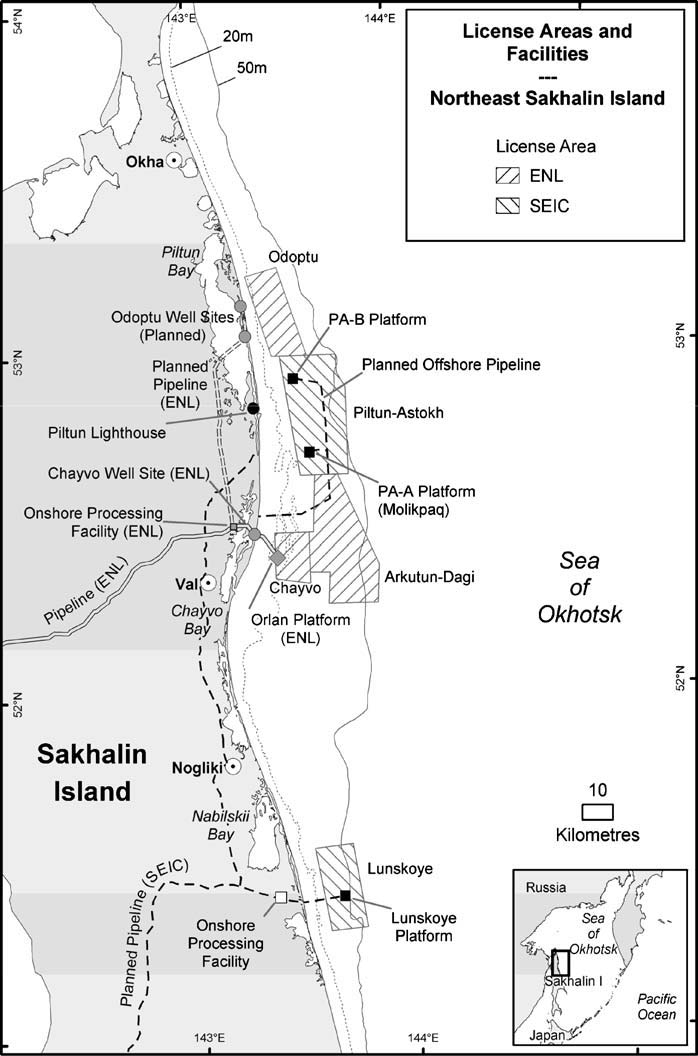
ENL and SEIC license areas and facilities, northeast Sakhalin Island
The multi-year industry-funded western gray whale research and monitoring program consists of (1) aerial surveys, (2) vessel surveys, (3) shore-based surveys, (4) photo-identification, (5) shore-based behavior studies, (6) acoustics monitoring, and (7) benthic/epibenthic prey studies. This paper presents information on the within- and between-season distribution and relative abundance of western gray whales recorded off the northeast coast of Sakhalin Island during vessel and aerial surveys. These are the first regular and systematic aerial and vessel surveys conducted to monitor this population and this is the first detailed description of the offshore feeding area discovered in 2001. The discovery of this gray whale feeding area was significant because during the previous 18 years of studies, only the Piltun feeding area had been described. In addition, as 2002 and 2003 were years with little or no offshore industrial activity along the northeast Sakhalin coast, this paper provides valuable information about natural or “background” variability in western gray whale distribution and abundance along the northeast Sakhalin coast. Understanding natural causes of whale movements is important in assessing and quantifying potential impacts of present and future industrial development in this area of Russia.
Materials and methods
Aerial surveys
Beginning in 2001, a program of replicated aerial surveys was conducted to measure the local and regional distribution and abundance of western gray whales. Approximately 60,000 km of aerial surveys were conducted during 2001–2003 along the northeast coast of Sakhalin Island. The aerial survey program consisted of (1) intensive (100% coverage) surveys adjacent to Piltun lagoon where gray whales were known to aggregate to feed, (2) intensive (100% coverage) surveys in the offshore area where gray whales were discovered feeding in September 2001, (3) extensive (33% coverage) surveys of the entire northeast Sakhalin coast, and (4) intensive (100% coverage) surveys along the coast adjacent to Lunsky Bay where SEIC’s Lunskoye license area is located (Fig. 3). No aerial surveys were conducted in the Lunskoye grid in 2001. Surveys were conducted by researchers from the laboratory of marine mammals at TINRO Center (Vladivostok).
Fig. 3.
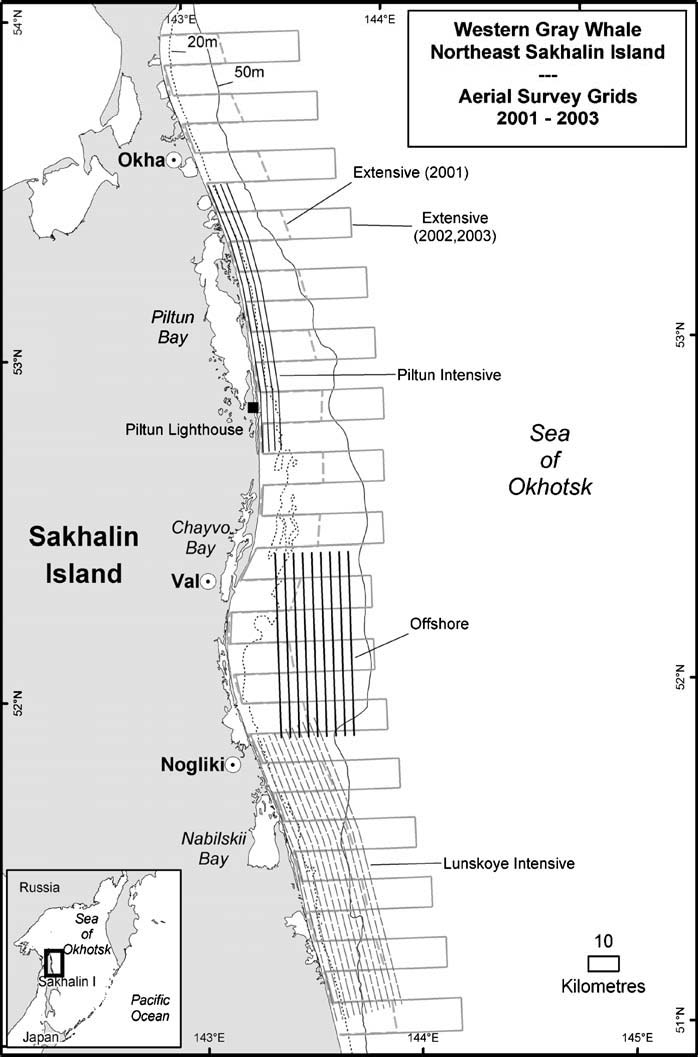
Aerial survey grids along the northeast coast of Sakhalin Island, 2001–2003
In 2001, aerial surveys were initially conducted in a Russian twin-engine MI-8 MTV helicopter. Starting on 4 August 2001, a specially outfitted Antonov 28 (AN-28) fixed-high wing twin turbo engine aircraft was used. Surveys in 2002 and 2003 were conducted in the AN-28 aircraft. During surveys, global positioning systems (GPS) were used for navigation and a radar altimeter was used to maintain the desired survey altitude above sea level (ASL).
Two observers and two pilots were present at all times. The two observers sat in bubble-window seats on opposite sides of the aircraft and surveyed a strip on each side of the aircraft. Sightings within and beyond a designated transect width were distinguished and clinometers were used to measure distances to whales. The intensive Piltun grid was surveyed at 300 m ASL and all other grids (offshore, Lunskoye and extensive) were surveyed at 500 m ASL. All surveys were conducted at 200 km/h but aircraft speed varied depending on wind direction and speed (see Yazvenko et al. 2007a,b).
White caps on the sea surface were the most significant factor limiting detectability of whales. More surveys were conducted during poor weather conditions in 2001 than 2002 and 2003 due to the inherent differences in the objectives of the surveys. In 2001, daily intensive surveys were conducted in the Piltun area to ascertain the local distribution of gray whales to assist the seismic vessel Nordic Explorer select lines to be surveyed each day (see Johnson et al. 2007). Surveys in 2002 and 2003 were only conducted when weather conditions were good.
2001: A total of 131 aerial surveys in all areas (Piltun, offshore, extensive sampling grids and reconnaissance surveys) were conducted (∼16,048 km; Table 1). Aerial surveys of the Piltun grid were initiated on 19 July, 17 days before the 3D seismic program and associated calibration trials began, and continued through 19 November, more than two months after seismic surveys ceased.
Table 1.
Sightings and numbers of gray whales recorded on- and off-transect during aerial surveys off northeast Sakhalin Island, 31 July–19 November 2001
| Survey period | Piltun | Offshore | Extensive | Lunskoye | Total | ||||||||||
|---|---|---|---|---|---|---|---|---|---|---|---|---|---|---|---|
| km | On | Off | km | On | Off | km | On | Off | km | On | Off | km | On | Off | |
| 31 July–02 Augustb | 0a | 69/79 | 7/12 | 0 | NS | NS | 0 | NS | NS | 0 | NS | NS | 0a | 69/79 | 7/12 |
| 02–10 Augustc | 0a | 127/142 | 23/31 | 0 | NS | NS | 0a | 0/0 | 0/0 | 0 | NS | NS | 0a | 127/142 | 23/31 |
| 11–16 August | 951a | 177/245 | 68/87 | 0a | 1/1 | 0/0 | 0 | NS | NS | 0 | NS | NS | 951a | 178/246 | 68/87 |
| 17–21 August | 618a | 77/98 | 10/12 | 0 | NS | NS | 0 | NS | NS | 0 | NS | NS | 618a | 77/98 | 10/12 |
| 22–31 August | 1251a | 111/145 | 31/41 | 0 | NS | NS | 117.8a | 11/16 | 0/0 | 0 | NS | NS | 1369a | 122/161 | 31/41 |
| 1–8 September | 2943 | 104/132 | 26/33 | 0 | NS | NS | 522.2 | 0/0 | 0/0 | 0 | NS | NS | 3465 | 104/132 | 26/33 |
| 9–20 September | 1563a | 62/76 | 16/28 | 1351.7a | 67/82 | 18/20 | 639.3a | 3/4 | 0/0 | 0 | NS | NS | 3554a | 132/162 | 34/48 |
| 21–30 September | 361a | 44/52 | 5/7 | 353.9a | 50/65 | 12/18 | 365.1 | 1/1 | 1/1 | 0 | NS | NS | 1080a | 95/118 | 18/26 |
| 1–10 October | 578 | 18/24 | 1/1 | 764.46 | 34/48 | 7/9 | 703.7 | 4/6 | 1/1 | 0 | NS | NS | 2047 | 56/78 | 9/11 |
| 11–26 October | 178a | 22/25 | 0/0 | 612.33a | 54/69 | 9/16 | 0 | 0/0 | 0/0 | 0 | NS | NS | 790a | 76/94 | 9/16 |
| 15–19 November | 540 | 18/23 | 7/9 | 972.93 | 4/7 | 1/1 | 662.2 | 0/0 | 0/0 | 0 | NS | NS | 2175 | 22/30 | 8/10 |
| Total | 8982 | 829/1041 | 194/261 | 4055 | 210/272 | 47/64 | 3010 | 19/27 | 2/2 | 0 | 16048 | 1058/1340 | 243/327 | ||
NS Not surveyed
a Some or all GPS data were missing, therefore, calculated survey effort (km2 ) is under represented.
b Including morning survey on 2 August
c Including afternoon survey on 2 August
In addition to surveys of the systematic sampling grids, five exploratory/reconnaissance surveys of remote areas north, northeast and southeast of Sakhalin Island were flown in 2001 in an attempt to document other potential gray whale feeding areas. These included surveys of Sakhalinskii Bay, portions of northern Tatar Strait, the Shantarskiye Islands and adjacent bays, and Terpeniya Bay (Fig. 1).
2002: Between 27 July and 18 November 2002, 26 aerial surveys were conducted in all areas (Piltun, extensive, offshore, and Lunskoye sampling grids); ∼13,428 km including nine partial surveys that covered at least one full transect (Table 2). The number of transects in the Lunskoye and Piltun grids were reduced by half; in the Piltun grid, only the first two (most coastal) transects were surveyed.
Table 2.
Sightings and numbers of gray whales recorded on- and off-transect during aerial surveys off northeast Sakhalin Island, 27 July–18 November 2002
| Survey period | Piltun | Offshore | Extensive | Lunskoye | Total | ||||||||||
|---|---|---|---|---|---|---|---|---|---|---|---|---|---|---|---|
| km | On | Off | km | On | Off | km | On | Off | km | On | Off | km | On | Off | |
| 27–31 July | 179 | 14/18 | 4/5 | 540 | 7/11 | 8/12 | 1455 | 6/7 | 2/2 | 1166 | 1/4 | 0/0 | 3340 | 28/40 | 14/19 |
| 2 August | 359 | 10/11 | 1/1 | 0 | NS | NS | 0 | NS | NS | 0 | NS | NS | 359 | 10/11 | 1/1 |
| 26 August | 361 | 15/21 | 0/0 | 0 | NS | NS | 0 | NS | NS | 0 | NS | NS | 361 | 15/21 | 0/0 |
| 1–5 September | 359 | 14/18 | 12/16 | 600 | 12/15 | 14/19 | 1448 | 0/0 | 4/6 | 580 | 0/0 | 0/0 | 2986 | 26/33 | 30/41 |
| 30 September | 360 | 9/13 | 0/0 | 540 | 8/12 | 2/2 | 0 | NS | NS | 0 | NS | NS | 899 | 17/25 | 2/2 |
| 9–10 October | 233 | 7/10 | 3/71 | 119 | 8/12 | 4/7 | 1213 | 3/7 | 1/2 | 580 | 0/0 | 0/0 | 2144 | 18/29 | 6/10 |
| 6–8 November | 624 | 15/18 | 5/18 | 482 | 1/1 | 1/1 | 680 | 2/5 | 0/0 | 0 | NS | NS | 1786 | 18/24 | 6/9 |
| 15–18 November | 90 | 3/5 | 0/0 | 536 | 12/16 | 5/12 | 353 | 0/0 | 0/0 | 572 | 0/0 | 0/0 | 1551 | 15/21 | 5/12 |
| Total | 2566 | 87/114 | 23/31 | 2817 | 48/67 | 34/53 | 5148 | 11/19 | 7/10 | 2898 | 1/4 | 0/0 | 13428 | 147/204 | 64/94 |
NS Not surveyed
2003: Between 5 June and 2 December 2003, 50 aerial surveys in all areas (Piltun, extensive, offshore, and Lunskoye sampling grids) were conducted (∼37,237 km), including partial surveys that covered at least one full transect (Table 3). All surveys were flown 300 m ASL, except transect #2 in the Piltun area on 19 September, which was flown 200 m ASL due to low overcast. Due to restricted time and poor weather, no single survey covered all nine survey transects in the offshore area. There were four near-complete surveys that covered seven to eight transects and eight partial surveys that covered one to four transects.
Table 3.
Sightings and numbers of gray whales recorded on- and off-transect during aerial surveys off northeast Sakhalin Island, 5 June–2 December 2003
| Survey period | Piltun | Offshore | Extensive | Lunskoye | Total | ||||||||||
|---|---|---|---|---|---|---|---|---|---|---|---|---|---|---|---|
| km | On | Off | km | On | Off | km | On | Off | km | On | Off | km | On | Off | |
| 5–7 June | 898 | 0/0 | 0/0 | 593 | 3/3 | 1/1 | 0 | NS | NS | 582 | 0/0 | 0/0 | 2073 | 3/3 | 1/1 |
| 5–15 July | 1245 | 42/61 | 18/29 | 727 | 7/14 | 3/9 | 10319 | 8/10 | 1/1 | 493 | 0/0 | 0/0 | 12784 | 57/85 | 18/29 |
| 18–20 August | 1067 | 61/87 | 17/20 | 480 | 3/6 | 2/4 | 0 | NS | NS | 579 | 0/0 | 0/0 | 2125 | 64/93 | 19/24 |
| 18–22 September | 1468 | 87/113 | 28/46 | 703 | 7/11 | 5/8 | 14510 | 3/4 | 7/11 | 580 | 0/0 | 0/0 | 17260 | 97/128 | 40/65 |
| 21–28 October | 897 | 34/45 | 0/0 | 471 | 0/0 | 0/0 | 0 | NS | NS | 578 | 0/0 | 0/0 | 1947 | 34/45 | 0/0 |
| 29 November–2 December | 269 | 1/1 | 0/0 | 398 | 2/3 | 0/0 | 0 | NS | NS | 381 | 0/0 | 0/0 | 1048 | 3/4 | 0/0 |
| Total | 5844 | 225/307 | 59/85 | 3372 | 22/37 | 11/22 | 24830 | 11/14 | 8/12 | 3192 | 0/0 | 0/0 | 37237 | 258/358 | 78/119 |
NS Not surveyed
Vessel surveys
A vessel-based marine mammal observer (MMO) program began in 2001 as a mitigation measure during ENL’s Odoptu 3D seismic survey. Systematic and opportunistic vessel surveys were conducted in both the Piltun and Offshore feeding areas (Fig. 4). Observers continuously recorded gray whales opportunistically during all daylight vessel-based research activities (i.e. during photo-identification, acoustics, and prey sampling studies) when dedicated surveys were not being conducted. Surveys were conducted at a speed of 8 kts by two observers stationed at the highest suitable observation point on the vessel. Observers used reticle binoculars to detect whales, resolve details during sightings, and estimate ranges. Information on sightability, weather, heading, distance from the vessel and general whale activity were recorded.
Fig. 4.
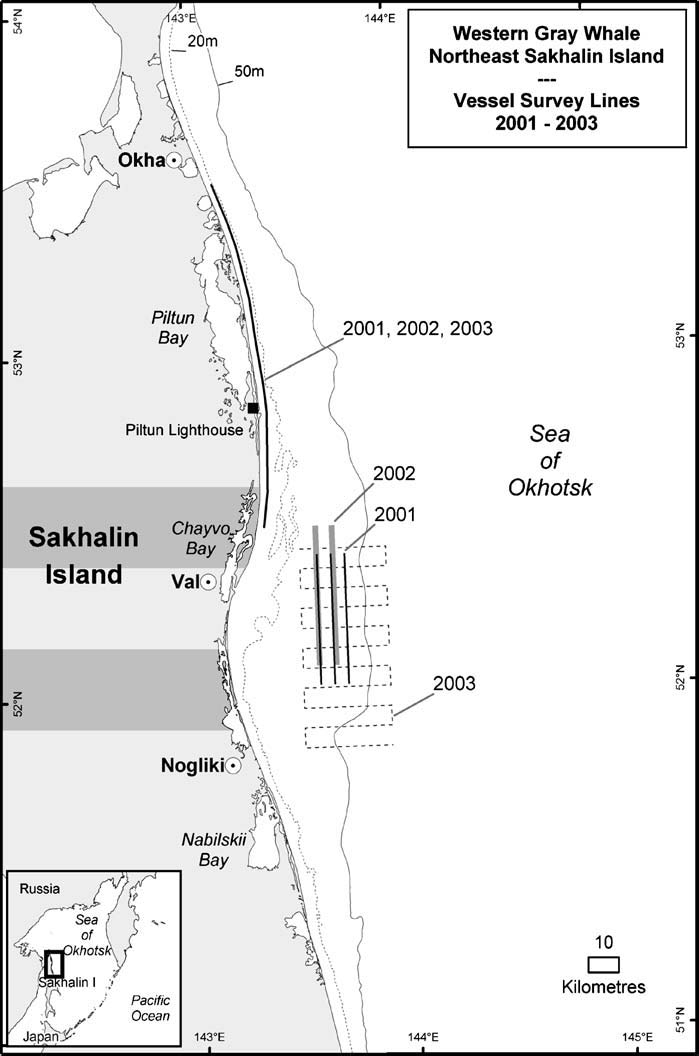
Vessel survey lines in the Piltun and offshore feeding areas, 2001–2003
In 2001, during the Odoptu 3D seismic survey, the primary objectives of the vessel-based MMO program was to ensure that the seismic ship operated beyond the safety buffer distance designated to reduce potential disturbance from noise on western gray whales, and to document the movements and activities of western gray whales observed in the Piltun area (Johnson et al. 2007). After the offshore feeding area was discovered on 10 September 2001 the vessel Rubin was used to survey an offshore N-S transect (20–25 km offshore) between 52°45′N and 52°00′N on 12 September. Subsequent to this initial survey, three longitudinal transects were established in this area and six surveys were conducted during 11–18 September from the Rubin (Table 4). These transects were surveyed again in 2002 (Table 5). In 2003, the longitudinally oriented transects were replaced with 11 latitudinally oriented transects (Fig. 4, Table 6).
Table 4.
Sightings and numbers of gray whales recorded during vessel surveys in the Offshore feeding area, 10 September–18 September 2001
| Date | Sightings | Numbers | Estimated number of transects |
|---|---|---|---|
| 10 Septembera | 2 | 7 | 0 |
| 11 September | NS | NS | NS |
| 12 September | 17 | 41 | 1 |
| 13 September | NS | NS | NS |
| 14 September | 25 | 81 | 3 |
| 15 September | 4 | 9 | 0.5 |
| 16 September | 14 | 51 | 2 |
| 17 September | 24 | 83 | 3 |
| 18 September | 16 | 48 | 1 |
| Total | 102 | 320 | 10.5 |
a Gray whales were discovered in the new offshore area on 10 September. Complete transects were not conducted on this date.
Table 5.
Numbers of gray whales recorded during vessel surveys off northeast Sakhalin Island, 1 September–16 November 2002
| Survey period | Piltun | Offshore | Total | ||||||
|---|---|---|---|---|---|---|---|---|---|
| km | Sightings | Whales | km | Sightings | Whales | km | Sightings | Whales | |
| 1–8 September | 202 | 40 | 76 | 260 | 25 | 62 | 462 | 65 | 138 |
| 9–16 September | 525 | 31 | 44 | 439 | 54 | 86 | 964 | 85 | 130 |
| 17–24 September | 0 | NS | NS | 410 | 48 | 83 | 410 | 48 | 83 |
| 25–31 September | 579 | 40 | 61 | 0 | NS | NS | 579 | 40 | 61 |
| 1–8 October | 363 | 13 | 17 | 0 | NS | NS | 363 | 13 | 17 |
| 9–16 October | 74 | 6 | 7 | 498 | 55 | 83 | 572 | 61 | 90 |
| Total | 1743 | 130 | 205 | 1607 | 182 | 314 | 3350 | 312 | 519 |
Table 6.
Sightings and numbers of gray whales recorded during vessel surveys off northeast Sakhalin Island, 26 July–26 September 2003
| Survey period | Piltun | Offshore | Total | ||||||
|---|---|---|---|---|---|---|---|---|---|
| km | Sightings | Whales | km | Sightings | Whales | km | Sightings | Whales | |
| 26–31 July | 311 | 1 | 1 | 0 | 0 | 0 | 311 | 1 | 1 |
| 1–9 August | 299 | 12 | 21 | 382 | 45 | 83 | 681 | 57 | 104 |
| 10–19 August | 341 | 44 | 72 | 548 | 36 | 67 | 889 | 80 | 139 |
| 20–31 August | 358 | 81 | 135 | 285 | 34 | 71 | 643 | 115 | 206 |
| 1–13 September | 313 | 86 | 130 | 520 | 77 | 117 | 833 | 163 | 247 |
| 14–26 September | 212 | 36 | 48 | 0 | 0 | 0 | 212 | 36 | 48 |
| Total | 1834 | 260 | 407 | 1735 | 192 | 338 | 3569 | 452 | 745 |
Density estimation
Aerial survey data were corrected using density estimation methods in order to accurately interpret inshore-offshore and N-S shifts in distribution. It is well known that observers do not detect or record all whales that are present in a survey area. Some animals that are at the surface at the time of a survey are missed, and some whales are below the surface where they cannot be detected when the survey aircraft or vessel is present. Calculation of whale density included correction factors for survey effort, sightability, and for whales that were below the surface when the aircraft was present. Sightability is an estimate of the probability of seeing a whale at a specified distance perpendicular to the transect centerline, given that a whale is present. Standard linetransect distance sampling methods (Buckland et al. 2001) were used to estimate sightability at different distances from the aerial transect centerline and to adjust the observed number of whale sightings. The probability that western gray whales were available to be seen on the surface of the water during a particular survey was based on the time an area of water was observed during a survey and whale dive cycle behavior. Behavior data regarding the amount of time western gray whales spend underwater was collected from shore-based stations in the Piltun feeding area (see Würsig et al. 2003; Gailey et al. 2004). Because the amount of time gray whales spend underwater in the Offshore area is unknown, data collected in shallow coastal waters was used to adjust density values in the offshore area. Since the water is generally deeper in the Offshore feeding area than the Piltun feeding area, whales may spend a greater time under water during a dive. Therefore the density of whales in the Offshore feeding area may be underestimated.
Data from vessel surveys were considered complimentary to the aerial data and were not used in whale density calculations or univariate statistical analyses. Distribution maps of vessel surveys show all sightings, including those from dedicated surveys and opportunistic observations recorded during other vessel tasks.
Only surveys flown during acceptable weather conditions were included in density calculations. Data from transects #3 and #4 of the Intensive (Piltun) survey area were not surveyed during many aerial surveys because of poor weather or time limitations. After examination of the available data, density estimates in the Piltun area were based on aerial surveys that included on-transect sightings of gray whales recorded on transects #1–3. Density estimates for gray whales in the Offshore area only included surveys where transects #1–9 were surveyed. Transects #10 and #11 in the Offshore feeding area were only surveyed once during 2001–2003 and were not included in analyses.
Results
Regional distribution along northeast Sakhalin Island
The distribution of gray whales was examined along the northeast coast of Sakhalin Island with both aerial and vessel surveys. Results of aerial and vessel surveys in all years indicated that gray whales occurred in predominantly two areas, (1) adjacent to Piltun Bay, and (2) offshore from Chayvo Bay, i.e., the Piltun and Offshore feeding areas respectively (Figs. 5, 6, 7, 8, 9, and 10). As stated earlier, vessel sighting data were considered supplementary to aerial surveys since very few systematic vessel surveys were conducted in comparison to aerial surveys. No gray whales were recorded in 2001 during reconnaissance aerial surveys in remote areas.
Fig. 5.
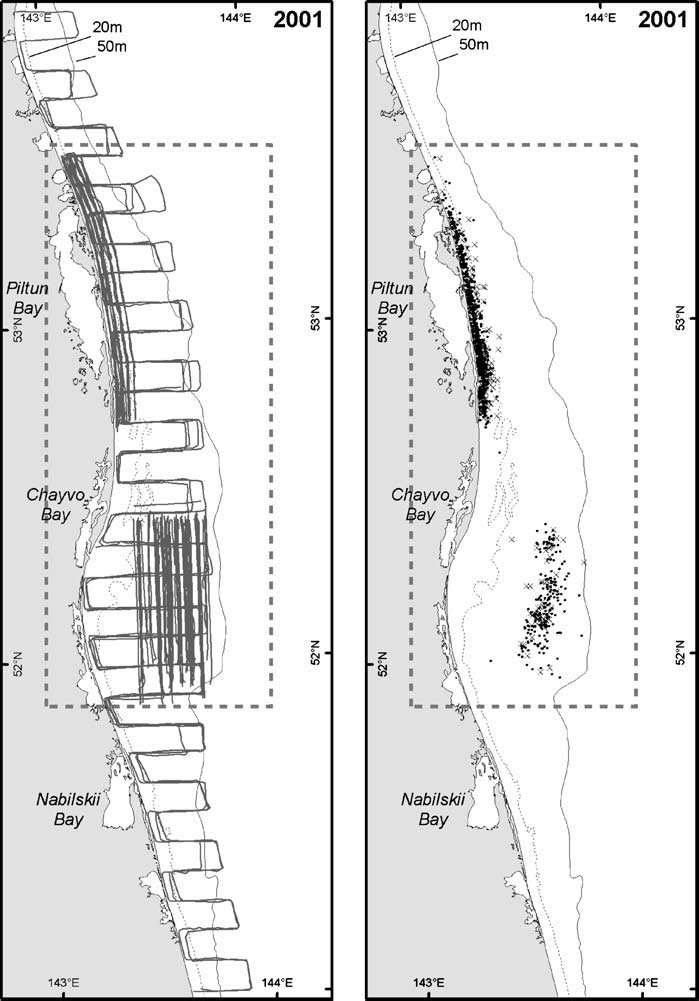
Aerial survey effort and distribution of gray whales along the northeast coast of Sakhalin Island, 2001. Dots and crosses represent on- and off-transect sightings, respectively
Fig. 6.
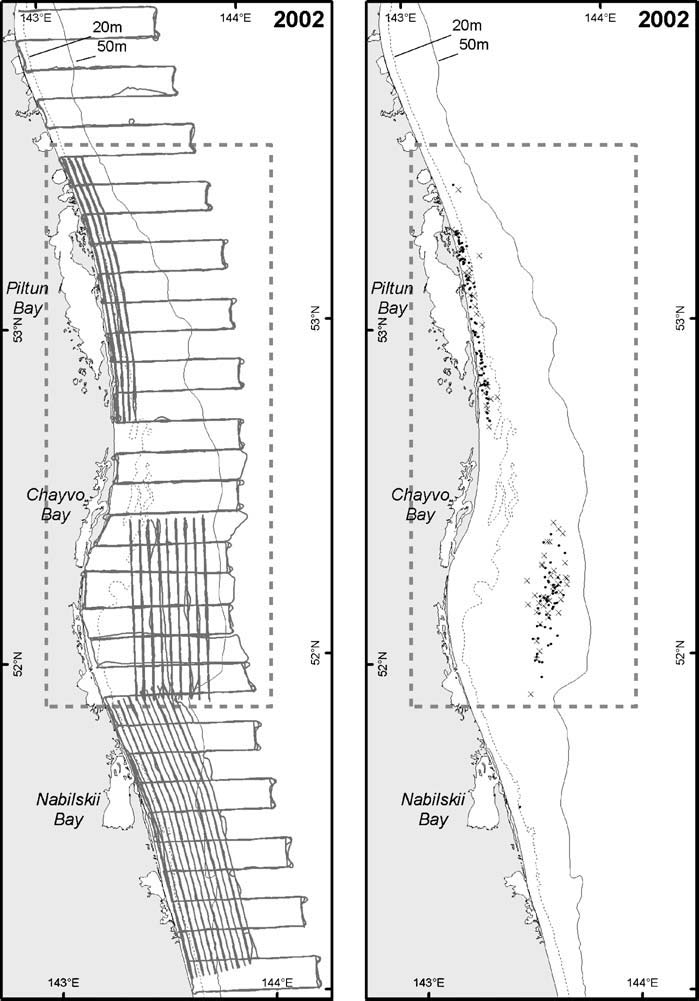
Aerial survey effort and distribution of gray whales along the northeast coast of Sakhalin Island, 2002. Dots and crosses represent on- and off-transect sightings, respectively
Fig. 7.
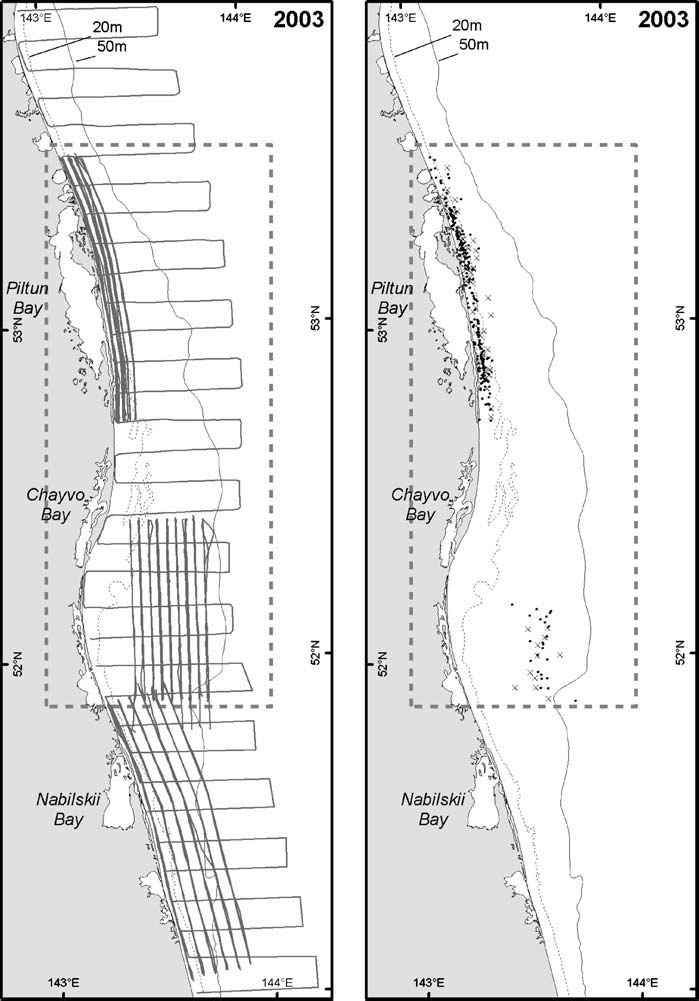
Aerial survey effort and distribution of gray whales along the northeast coast of Sakhalin Island, 2003. Dots and crosses represent on- and off-transect sightings, respectively
Fig. 8.
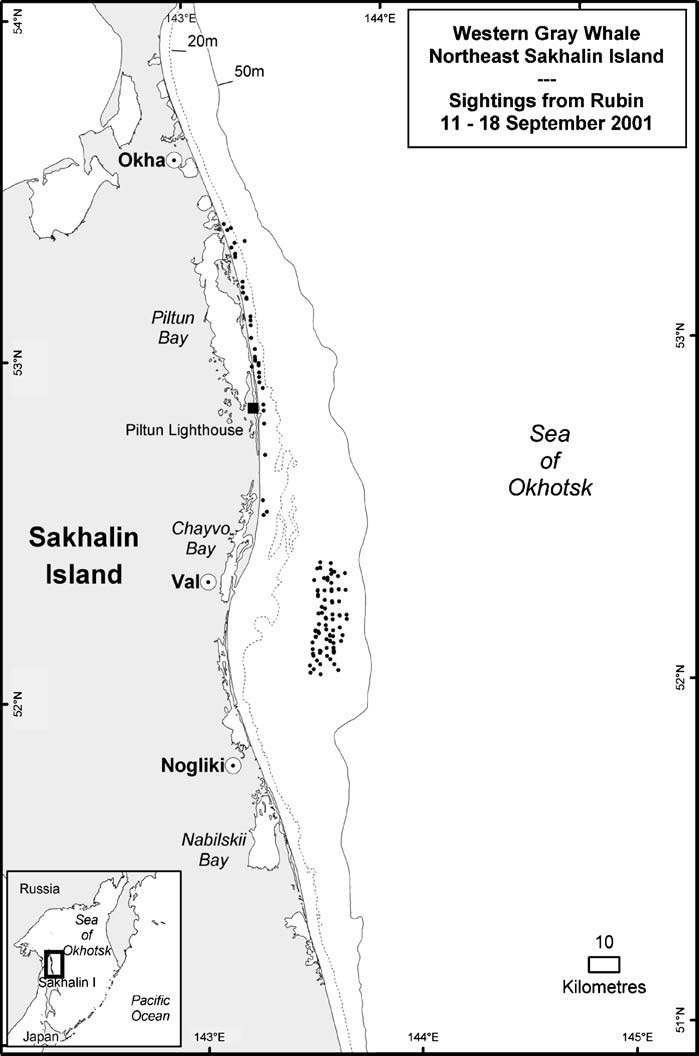
Gray whale sightings recorded from the Rubin during 11–18 September 2001 in the newly discovered offshore feeding area and along the coast in the Piltun feeding area
Fig. 9.
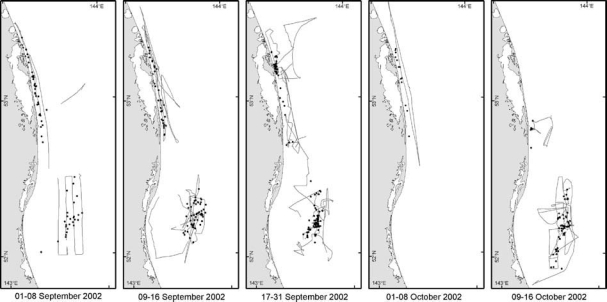
Gray whale sightings and vessel tracklines during dedicated and opportunistic vessel surveys in the Piltun and offshore feeding areas over weekly sampling periods, 2002
Fig. 10.
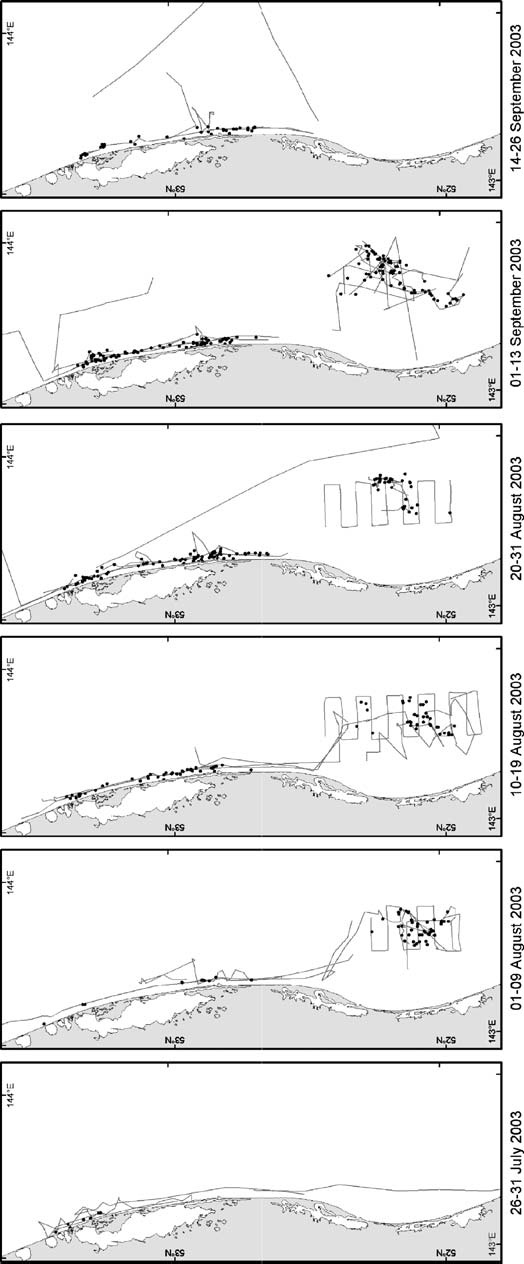
Gray whale sightings and vessel tracklines during dedicated and opportunistic vessel surveys in the Piltun and offshore feeding areas over weekly sampling periods, 2003
On 3 September 2002, while traveling from Vladivostok to the main study area along the northeast coast of Sakhalin Island, the research vessel Nevelskoy encountered a group of three gray whales east of Cape Terpenia, along the southeast coast of Sakhalin Island (Fig. 1), where water depths range from 110–120 m. Whale movement was unidirectional and the animals were not displaying typical feeding behaviors such as milling in one location or diving, indicated by the display of the tail flukes, suggesting that they were not feeding but traveling through the area.
Piltun feeding area
Extensive aerial surveys along northeast Sakhalin Island indicated that whales occurred in a distinct area adjacent to Piltun Bay, termed the Piltun feeding area. Intensive aerial surveys, in addition to vessel surveys, provided information regarding the seasonal distribution and abundance of gray whales within the Piltun feeding area.
Seasonal distribution
During all years, the distribution of whales changed throughout the season within both the Piltun and Offshore feeding areas (Figs. 11, 12, and 13). Both N-S movements and inshore-offshore movements were examined in these areas (Figs. 14, 15, and 16) using distance line transect sampling methods outlined above.
Fig. 11.
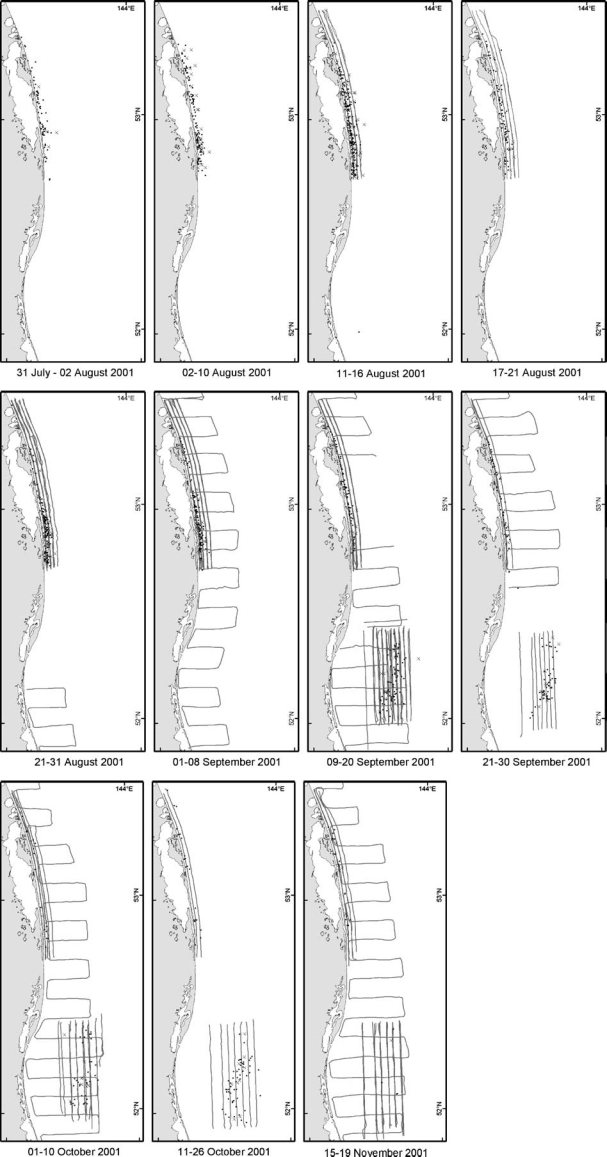
Gray whale sightings and aerial tracklines during aerial surveys in the Piltun and offshore feeding areas over weekly sampling periods, 2001. Dots and crosses represent on and off-transect sightings, respectively
Fig. 12.
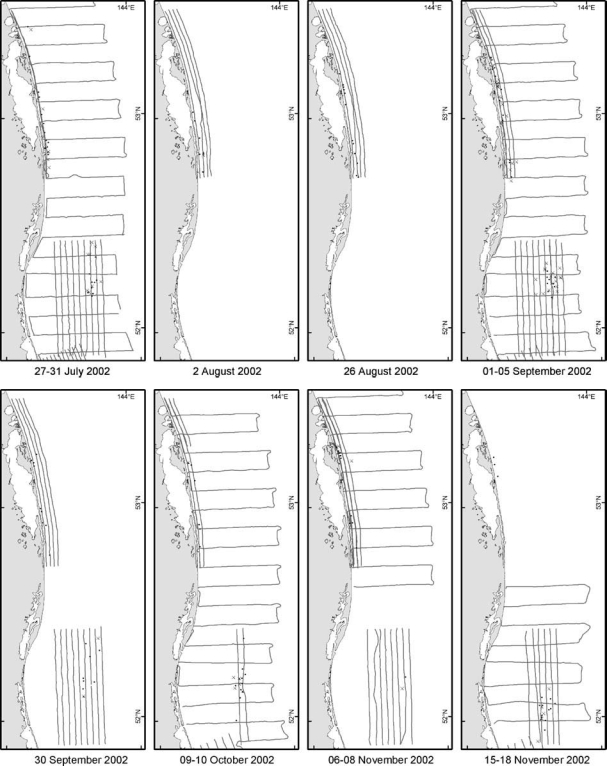
Gray whale sightings and aerial tracklines during aerial surveys in the Piltun and offshore feeding areas over weekly sampling periods, 2002. Dots and crosses represent on and off-transect sightings, respectively
Fig. 13.
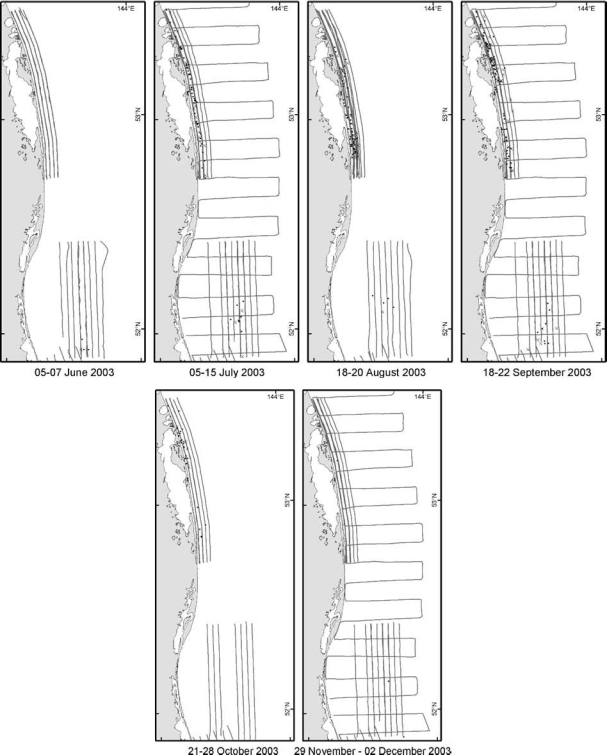
Gray whale sightings and aerial survey tracklines in the Piltun and offshore feeding areas over weekly sampling periods, 2003. Dots and crosses represent on and off-transect sightings, respectively
Fig. 14.
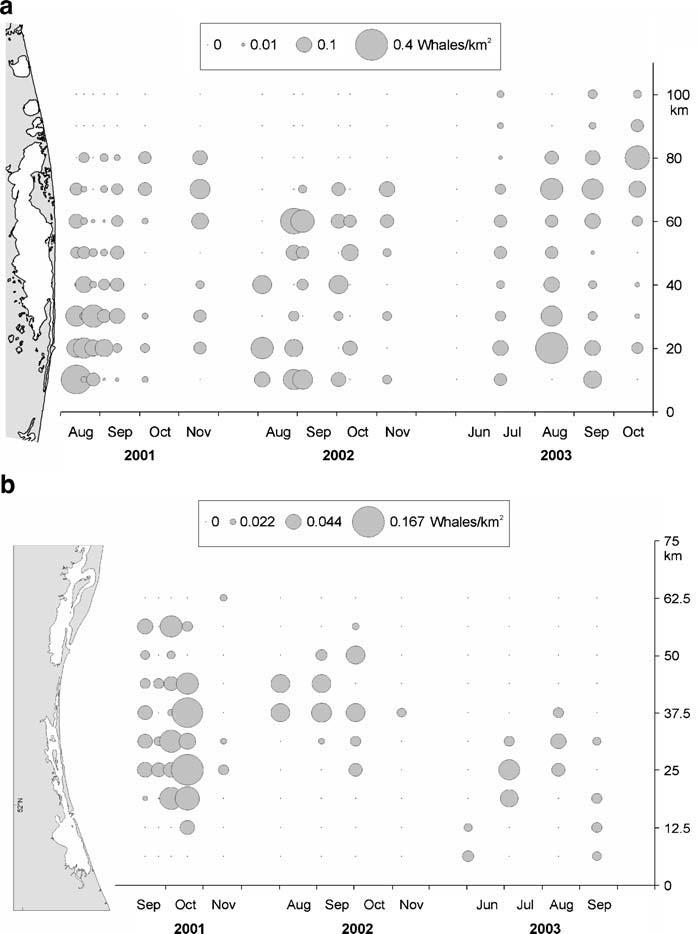
Density of gray whales per month along the a Piltun and b offshore feeding areas, 2001–2003
Fig. 15.
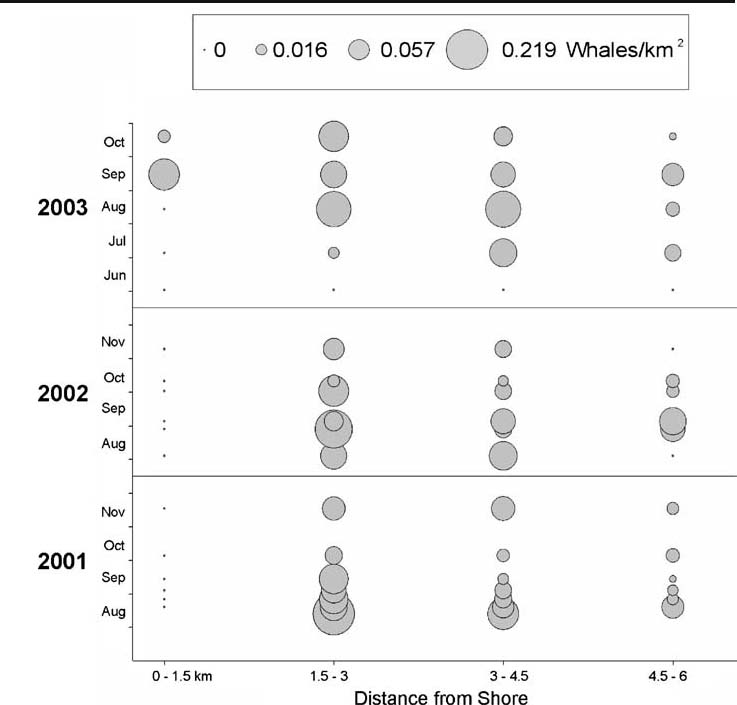
Density of gray whales per month as a function of distance from shore in the Piltun feeding area, 2001–2003
Fig. 16.
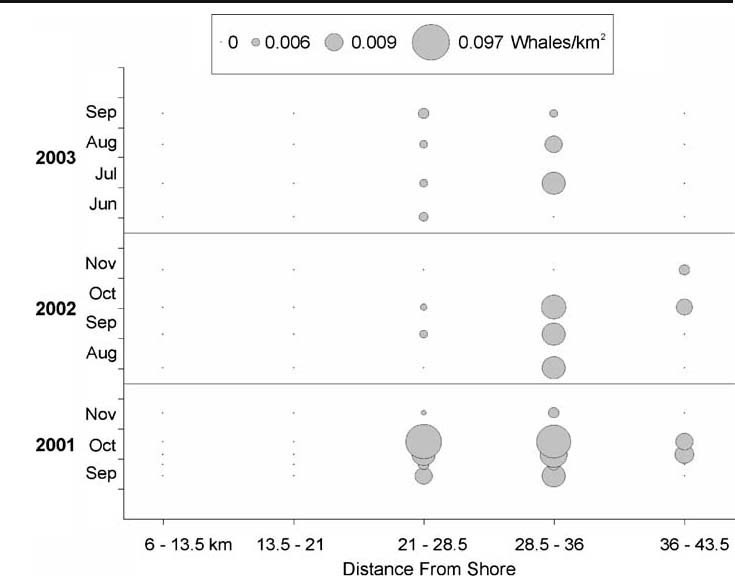
Density of gray whales per month as a function of distance from shore in the offshore feeding area, 2001–2003
In 2001, gray whales were distributed in waters <20 m deep within 5 km of shore. Variation in the latitude of gray whale sightings was observed between July and November in the Piltun feeding area (Figs. 11 and 14a). Gray whales remained and continued to feed in shallow (<20 m) waters west of the Odoptu block throughout the entire 3D seismic survey period. N-S shifts in the distribution of whales in the Piltun feeding area were observed both during (17 August to 9 September) and after seismic data acquisition was completed. During the seismic acquisition period a correlation was found between sound from seismic activity and movement of some whales to the southern part of the feeding area (see Yazvenko et al. 2007a).
In order to qualitatively discuss the latitudinal location of whale sightings along the Intensive survey, each transect was subdivided into five equal segments, or “blocks”, with block 5 in the far north and block 1 in the far south. In 2002, gray whales were observed in the southern part of the survey area in late July/early August (see Figs. 12 and 14a). From September to mid-October, more than half the whales were observed in central parts of the survey grid (blocks 2 and 3). In November, about 70% (9 of 13) of the whales were observed in the northern part of the survey grid (block 4). No whales were observed in 2002 in the northernmost part (block 5) of the survey grid during Intensive surveys. However, two whales were observed in block 5 during an extensive survey on 31 July. All whales, except for five individuals, were observed within the 4-km-wide strip of nearshore feeding habitat in the Piltun feeding area; 69.8% of whales were observed on transect #1 within 2 km of the coast. No whales were observed further than 5 km from the coast during the surveys of the Piltun grid in 2002. The five whales recorded outside the 0–4 km coastal strip were 5–7 km from the coast during surveys of the extensive aerial survey grid.
In 2003, gray whales were present in all five blocks at similar densities over the entire Piltun area in July (Figs. 13 and 14). In August, more whales (31 of 51 sightings) were observed in the southern part of the area (blocks 1 and 2). In September and October, gray whales were seen at higher densities in the northern half of the area (0.091 whales/km2) compared to the south (0.04 whales/km2) during both vessel and aerial surveys. Approximately 95% of whales were observed <4 km from shore. The mean distance from shore of whale sightings in the Piltun area was 1987 m±70.5 m), i.e., most sightings were on transects #1 and #2. Approximately 85% of whales (full and partial surveys combined) were observed within 3 km from shore in waters shallower than 20 m. In surveys where all four transect lines were surveyed, 92.3% (on- and off-transect sightings) or 91.8% (ontransect sightings only) of whales were seen on transects #1 and #2.
Seasonal abundance
In all years, the abundance of whales varied among surveys, and variations in sightability conditions did not allow definite conclusions regarding within-season dynamics and densities of gray whales in the area.
During all years, the largest number of whales was observed in late-August and early-September and the lowest number observed in November. In 2001, the number of gray whales peaked in August and began to decrease in September (see Table 1). In 2002, the greatest number of whales in the Piltun feeding area was observed at the end of August and the beginning of September. The number of whales decreased in October and November (see Table 2). In 2003, the number of whales recorded in the vicinity of Piltun Bay varied in different months but the trend was an increase in the number of whales until 20 August when 27 whales were recorded on-transect and 39 were recorded on- and off-transect. The number of whales recorded in the area declined in September and October. On 29 November, the coastal waters near Piltun Bay were covered with young ice (frazil), and no whales were detected. However, on 2 December 2003, one whale was sighted 3 km from shore where frazil ice had dispersed.
Offshore feeding area
Discovery of the offshore feeding area
The most significant result of the 2001 aerial and vessel surveys was the discovery and subsequent systematic surveying of a major western gray whale summering and feeding area, the offshore feeding area, located 25–40 km offshore Chayvo Bay, Sakhalin Island. A total of six vessel-based surveys were conducted in the offshore feeding area during 11–18 September 2001. During these surveys, a total of 102 sightings of 320 whales were recorded by MMOs aboard the Rubin (Table 4). The maximum number of whales recorded during a single survey of this offshore feeding area was 83 on 17 September 2001. The average number of whale sightings and individuals recorded during these surveys was 17.0 and 52.2, respectively. The number of whales per sighting ranged from 1 to 11 individuals with a mean group size of 3.1.
Twenty-two aerial surveys were also conducted in the offshore feeding area during the post-seismic survey period from 11 September until 17 November 2001 (Fig. 11, Table 1). In total, 281 sightings of 369 whales were recorded on- and off-transect in this area by all observers, with an average of 12.8 sightings and 16.8 gray whales per survey (mean group size= 1.3). The number of whales sighted during aerial surveys fluctuated between 0 (17 November) and 53 whales (24 September). Whales were displaying feeding behaviors such as diving, indicated by the display of tail flukes, and sediment plumes from benthic feeding were observed, indicating that whales were feeding at depths ranging from 35 to 40 m.
Seasonal distribution
In 2001, the distribution of gray whales in the offshore feeding area was not uniformly distributed across the aerial survey grid. A general shift in the center of the distribution ∼15 km to the south, superimposed on some short-term N-S shifts within the general feeding area, was recorded during September–October, and a further shift to the south was observed in November 2001 (Figs. 11 and 14b). However, a subarea in the southern part of the larger offshore feeding area centered near 52°07′N and 143°35′E was the core feeding area for almost the entire study period (Fig. 11).
In 2002, the area in which whales were observed during aerial and vessel surveys stretched between 51°51′N and 52°24′N and between 143°31′E and 143°44′E. This comprised an area ∼900 km2 which was utilized during the entire feeding season (Figs. 6, 9 and 12). The highest density of whales in the offshore aerial survey grid were observed along transects #6 and #7 (23 of 35 sightings) and most sightings occurred in the northern half of the survey grid (see Fig. 14b). In November, whales were observed in the southern part of this area.
In 2003, whales were more often observed during aerial surveys on transects #4 to #6 (0.019 whales/km2) in the southern half of the survey area, and a lower density of whales was recorded on transects #7–9 (0.001 whales/km2) than in 2002 (0.024 whales/km2; Fig. 14b). The distribution of gray whales shifted to the north within this area over the season i.e., from June to August (Figs. 13 and 14b). During opportunistic observations from the vessel Nevelskoy on 26–28 August, whales were observed concentrated along the eastern border of the aerial and vessel survey sampling grids, in an area between 52°06′–52°12′N (Fig. 10). Some whales were seen as far east as 143° 47′E in waters up to 65 m deep. The Nevelskoy returned to the offshore feeding area on 5 September and prey sampling, photo-identification and acoustic monitoring was conducted from the vessel. Gray whale sightings were recorded during these activities. During the first half of September, whales were observed both within the vessel survey area and to the northeast of the vessel survey area in an area near 52°10′–52°16′N, 143°44′–143°54′E (Fig. 10). These whales were subsequently photo-identified and prey sampling was conducted in the area where whales were observed feeding (Yakovlev and Tyurneva 2004; Fadeev 2004).
Seasonal abundance
In all years, the abundance of whales varied among surveys, and variations in sightability conditions did not allow definite conclusions regarding within-season dynamics and densities of gray whales in the area. In 2001, aerial surveys of the offshore feeding area began shortly after its discovery on 10 September. The numbers sighted per survey fluctuated between 0 (17 November) and 53 gray whales (24 September) with an average of 12.8 sightings and 16.8 whales per survey.
In 2002, the offshore feeding area was surveyed by aircraft from July–November. The largest number of whales recorded on-transect in the offshore area during 2002 was 16 animals on 18 November. The number of whales recorded varied greatly, partly because weather conditions and sightability were poor during some surveys and because the number of transects surveyed was not constant among surveys.
In 2003, gray whales were present in the offshore area from early June through the end of November. As in the Piltun area, the number of whales recorded in the offshore area was not constant throughout the season. The largest number of gray whales (14) was observed on 8 July; the least, in June (3) and November–December (3 and 0); in October, there were no whales seen.
Lunskoye area
On 28 July 2002, four gray whales were sighted on the Lunskoye survey grid (Fig. 6). In 2003, whales were not observed in the Lunskoye region during aerial surveys. No systematic vessel surveys were conducted in the Lunskoye area during 2001–2003.
Discussion
Aerial and vessel surveys conducted during 2001–2003 showed that from June to December along the northeast coast of Sakhalin Island, gray whales primarily occupy two main feeding areas, (1) adjacent to Piltun Bay and (2) offshore of Chayvo Bay in waters 25–65 m deep. In the Piltun feeding area, the majority of animals were observed in waters shallower than 20 m and were distributed from several hundred meters to ∼5 km from the shoreline.
Discovery of the offshore feeding area
The discovery of whales feeding in the offshore area each year was a substantial finding of this study. The existence of a second feeding area raises questions regarding western gray whale abundance and population levels, feeding behavior and ecology, and individual site-fidelity. The discovery of the offshore feeding area in late 2001 also raises the question whether this area was only used by gray whales starting in 2001, or whether it has been used in previous years. Weller et al. (2002a) reported that no whales had been observed in this offshore area prior to 2000 when eight gray whales were sighted by a Japanese research vessel (Miyashita et al. 2001). However, other sightings have been recorded. Five whales were first noted in this area during aerial overflights on 21 July 1995 (Sobolevsky 1998), three whales were sighted in the area during aerial overflights on 3 October 1998 (Naberezhnykh 2001, personal communication) and one gray whale was recorded in the area during an aerial survey on 23 June 2000 (Sobolevsky 2001). Prior to 2001, no intensive (fine-scale) systematic aerial or vessel surveys of this area were conducted, and given the limited survey effort prior to 2001, it is likely that gray whales used this area for feeding prior to 2001.
When whales were observed using this offshore area for feeding in 2001, it was suggested that whales may have shifted from coastal feeding habitat adjacent to Piltun Bay to “secondary” habitat offshore to avoid noise from a seismic survey (Weller et al. 2002b). However benthic prey studies conducted from 2002–2003 indicated that the offshore feeding area is rich in gray whale forage species, and is dominated by tube-dwelling ampelescid amphipods (Fadeev 2003, 2004). Amphipod biomass in this area is comparable to or higher than values reported for eastern gray whale feeding areas in the Bering Sea (Thomson 1983; Thomson and Martin 1983; Nerini 1984). The quality and quantity of prey present in the offshore feeding area, in addition to the fact that whales continued to use the area in 2002 and 2003, both of which were years with no offshore industrial development, suggests that this area provides an additional feeding habitat with prey biomass significantly greater than reported for the Piltun feeding area. However, it is important to note the females with calves have not been observed in the offshore feeding area during aerial, vessel or photo-identification surveys (Yakovlev and Tyurneva 2003, 2004, 2005, 2006), suggesting that the area adjacent to Piltun Bay is an important nursing habitat for some individuals in the population. Age and gender stratification in habitat use has been reported in eastern gray whales (Duffus 1996; Darling et al. 1998) and females with calves may prefer shallow, coastal waters that offer more protection from potential predators, such as killer whales that are observed in the study area (Gailey et al. 2004).
Seasonal distribution and abundance
Aerial and vessel surveys indicated that the distribution and abundance of whales in the Piltun and offshore feeding areas changed within and between seasons. Calculations of whale density over time showed that whales were dynamic in their movements in the study area during the May to December feeding period with both N-S and inshore-offshore movements. Gray whales were irregularly distributed and their distribution along the coast changed within and between years. Seasonal patterns of N-S redistribution of gray whales along the coast were observed in 2001–2003 and were similar among years. In general, in August, gray whales gravitated to the southern parts of the Piltun feeding area whereas in September to November they tended to concentrate in northern parts. The causes of the local movements of gray whales within the Piltun feeding area remain unknown. In 2001, some whales were reported to have shifted from the north to south in the Piltun feeding area in response to a seismic survey conducted in the Odoptu license area (Weller et al. 2002b; Johnson et al. 2007; Yazvenko et al. 2007a,b). Similar shifts in this area have been observed during other years in the absence of known anthropogenic influences [Würsig et al. (1999); Sobolevsky (2000,2001); Blokhin and Burdin (2001); Tsidulko (1998) cited in Weller et al. (2002b); Ivashchenko (1999) cited in Weller et al. (2002b)]. Concurrent shore-based behavioral observations of gray whales in the Piltun feeding area in 2002 and 2003 concluded that more gray whales occurred in the northern part of the area compared to the southern part (Würsig et al. 2003; Gailey et al. 2004).
In the offshore feeding area during all years, the distribution of gray whales extended from SW-NE, however there was also some redistribution of gray whales within the area. In 2001 and 2002, most gray whales were observed in the northern and central parts of the offshore feeding area, while in 2003 most of them were in the southern half. The distribution was patchy and was observed to change within seasons. In 2003, opportunistic vessel observations indicated a large number of gray whales in August and September feeding at depths >60 m seaward of the eastern boundary of the offshore aerial survey grid-outside the range of view of the aerial survey observers. This in an important development demonstrating the mobility and flexibility of gray whales; this eastern shift is assumed to have been due to interseasonal changes in the distribution and abundance of gray whale prey. In 2003, gray whales could have been present east of the defined survey area during the entire season, however it is equally plausible that the distribution of whales shifted eastward in late August. It is also possible that whales were located in this same part of the offshore area in 2002 but were undetected since no aerial or vessel surveys were conducted in waters greater than 50 m deep.
Seasonal variability in the distribution and abundance of cetaceans has been extensively reported and is thought to be a response to seasonal habitat fluctuations and movements of prey (Payne et al. 1986, 1990; Kenney et al. 1995; Wilson et al. 1997; Forney and Barlow 1998; Karczmarski et al. 1999; Reid et al. 2000; Baumgartner et al. 2003; Macleod et al. 2004). The distribution of feeding eastern gray whales along the west coast of North America is variable within and between years with whales utilizing areas from northern California to southeast Alaska from spring to fall, with significant interchange of individuals (confirmed by photo-identification) between areas with variable use of habitat within and between years (Calambokidis et al. 2002). Moore et al. (2003) reported substantial intra- and inter-annual variability in eastern gray whale distribution and abundance in the northern Bering Sea and indications of strong prey selection. Eastern gray whales feeding along the west coast of Vancouver Island, Canada also show strong prey selection and rotating among feeding sites and prey types within and between summer feeding seasons. These patterns have been shown to be a function of the distribution and abundance of their prey (Darling et al. 1998; Bass 2000; Dunham and Duffus 2001, 2002; Meier 2003). Eastern gray whales appear to be dynamic and selective foragers that can use various types of prey and foraging tactics rapidly to take advantage of short-term availability of energy; they are not exclusively benthic foragers (Dunham and Duffus 2001, 2002; Moore et al. 2003). We suggest that gray whales are multi-scale animals that can show site-fidelity at a regional scale (e.g., northeast Sakhalin Island) but can range over a larger area to use smaller sites or “nodes” within the region as a function of the distribution and abundance of prey over time (Darling et al. 1998; Calambokidis et al. 2002). In addition to responding to the distribution and abundance of prey, there is some evidence that eastern gray whales and other apex predators can significantly influence the distribution and abundance of their prey through foraging (Bowen 1997; Moore et al. 2003; Springer et al. 2003). These “top-down” effects can alter a prey community to the extent that whales will abandon it for months or years while it recovers to a richness that can be utilized again, influencing the seasonal distribution of the whales (Bass 2000). Although the western gray whale population is genetically isolated from the eastern gray whale population (Leduc et al. 2002), it is likely that eastern and western gray whales make foraging decisions in response to the distribution and abundance of prey in different ecological contexts in similar manners.
Fluctuations in the number of whales observed within the Piltun and offshore feeding areas and sparse sightings of gray whales outside of them indicate that whales are to some extent moving between the Piltun and offshore feeding areas during their summer-fall feeding season. Photo-identification studies have shown that there is interchange of individuals between the Piltun and offshore feeding areas both within- and between-feeding seasons (Yakovlev and Tyurneva 2003, 2004, 2005, 2006), however information on the rate and extent of such exchange is limited. The reasons why individuals travel between these two areas is unknown but it may be a foraging tactic influenced by the distribution and abundance of prey and/or intraspecific competition.
Gray whales first appear off northeast Sakhalin Island after ice starts to leave coastal waters, and they begin to depart Sakhalin Island for wintering areas in October (Blokhin and Burdin 2001). Gray whales have been observed off northeast Sakhalin Island in small numbers from May through late November or December (Blokhin 1996). It is important to note that in this study, surveys began in June and the distribution in May was not documented. In 2003, the earliest aerial survey occurred in June. Ice of various densities was still present in the immediate vicinity of the shore in early June, which might have accounted for the lack of sightings of western gray whales in the Piltun feeding area at this time. However, a small number of sightings were reported in the offshore feeding area during this early period.
Both vessel and aerial surveys showed that the number of gray whales in the Piltun and offshore feeding areas fluctuated throughout the season. The greatest number of whales was observed in August, and an appreciable reduction in the number of gray whales occurred in October and November. Since the sea off the northeast coast of Sakhalin is still free of ice at that time, the presence of ice does not seem to be the main reason for the late-fall decline in the number of gray whales along NE Sakhalin. One possible reason for decreasing numbers of gray whales late in the season includes the depletion of prey.
Density estimation and extrapolation of the average number of whale in both the Piltun and offshore feeding areas each year suggested that twice as many whales used the Piltun area in 2003 compared to 2001 and 2002. This is an interesting result because prey studies showed that the offshore feeding area is highly rich in tube-dwelling ampeliscid amphipods. Within and between season shifts in the distribution of gray whales between and within both the Piltun and offshore feeding areas are thought, in part, to be a response to seasonal changes in the distribution and abundance of prey (Fadeev 2002, 2003, 2004, 2005, 2006). A number of benthic studies (Koblikov 1983, 1986; Kussakin et al. 2001; Fadeev 2002, 2003, 2004, 2005, 2006) have indicated that the shallow coastal waters near Piltun Bay support benthic organisms that may be suitable as prey for gray whales (Rice and Wolman 1971; Thomson 1983; Thomson and Martin 1983; Nerini 1984; Blokhin and Pavlyuchkov 1988). In particular, Fadeev (2002, 2003, 2004, 2005, 2006) found that at depths of 5 to 15 m, this area is characterized by an abundance of potential prey organisms, primarily amphipods and isopods. We speculate that seasonal redistribution of gray whales in the Piltun and offshore areas may also be connected with changes in distribution and availability of their prey, however the fine scale data do not exist with which to support this speculation. Nevertheless, benthic sampling in spots where western gray whales were feeding showed consistently high levels of biomass of potential prey organisms, primarily amphipods (Fadeev 2003, 2004, 2005, 2006). This pattern is similar to that observed for eastern gray whales in the Clayoquot Sound region along Vancouver Island, Canada (Dunham and Duffus 2001, 2002; Meier 2003) and in the Bering Sea (Thomson and Martin 1983; Moore et al. 2003). Fluctuations in the number of whales in each feeding area within- and between-years is likely a function of prey dynamics, however such strong preference for the Piltun feeding area in 2003 is a bit perplexing when one considers the availability of prey in the offshore area. This suggests that the mechanism driving the movements of individuals along the northeast coast is very complex and influenced by a multitude of factors.
Other areas
In 2001, no gray whales were observed during aerial surveys of northern areas such as Sakhalinskii Bay, northern Tatar Strait, the Shantarskiye Islands and adjacent bays, and in southern areas such as Terpeniya Bay. In 2002, four gray whales were sighted in the Lunskoye aerial survey grid and in 2003, no gray whales were observed in the Lunskoye region during aerial surveys. However, in August–September 2003, marine mammal observers who were engaged in a vessel-based marine mammal observer program for a SEIC 3D seismic survey in the area, sighted several gray whales feeding along the coast at 15–35 m depths between 51° 30′N and 51°45′N (SEIC 2003). These observations indicate that this area may provide additional feeding habitat for gray whales, however, more data are needed to clarify this issue. Ranging behavior of some individual gray whales along the coast of Sakhalin Island is consistent with observed foraging behavior of eastern gray whales (Calambokidis et al. 2002). Small numbers of western gray whales were periodically observed outside the Piltun and offshore feeding areas during this study and it has been reported that individuals photo-identified in the Piltun feeding area have been later observed ranging as far as the Kuril Islands (Burdin et al. 2002). Gray whales have also been reported off the coast of northern Primorye on the Russian mainland in October (Vladimirov 1994). It is unknown why some individuals range outside of known feeding areas, but these movements may be related to prey availability, intraspecific competition, environmental cues, or memory. It is unlikely that the amount of prey in the Piltun and offshore feeding areas is limiting for ∼120 gray whales, therefore the reasons for these excursions are a mystery.
Conclusion
This paper has provided important information about the range, seasonal habitat use and relative abundance of western gray whales along the northeast Sakhalin coast. Within- and between-season patterns in the distribution and abundance of western gray whales were observed and distribution surveys are continuing on an annual basis to continue to document and monitor these patterns. We hypothesize that the mechanism driving these seasonal movements are seasonal fluctuations in the distribution and abundance of prey. With increasing offshore oil and gas development along this coast, understanding what natural variables influence the distribution and abundance of western gray whales is important to interpret causes for whale movements and to effectively mitigate potential effects of industrial activities.
Acknowledgement
Many people contributed to the overall success of the western gray whale vessel and aerial monitoring programs and the subsequent analyses and reporting. Special thanks to the team of vessel-based observers and aerial observers from the Pacific Research Institute of Fisheries and Oceanography (TINRO Center) and Institute for Marine Biology (IBM) in Vladivostok, Russia. We thank Caroline Martin, Mike Jenkerson and Daniel Egging of ExxonMobil Development Company, Houston, Texas and Rodger Melton and James Hall of ExxonMobil Upstream Research Company, Houston, TX. We also thank James Robinson, Ali Onder, Lisanne Aerts, Sergei Balytsok, and Tatyana Konovalova of Sakhalin Energy Investment Company, Yuzhno-Sakhalinsk. Vostok Air Services provided reliable and safe helicopter and fixed-wing aircraft support. Greg Manelick, Dmitry Mayorov and Oleg Shuranov provided valuable logistics support at the Nogliki base camp and in Yuzhno-Sakhalinsk on Sakhalin Island. We also thank the captains and crews of the Nordic Explorer, Rubin, Atlas, and Nevelskoy for their cooperation. Various other Russian and North American scientists provided important advice and guidance during the various workshops, planning sessions, project reviews, and report reviews. For help with these tasks we thank Vyacheslav Shuntov, Yuri Blinov, Valery Vladimirov, Evgeny Sobolevsky, Gennady Fedoseev, Vladimir Radchenko, Alexander Burdin, Charles Malme, Dave Duffus, Steve Johnson, Rolph Davis, Jack Lawson, Robin Tamasi, Lucia Ferreira, Dorothy Baker, Julia Iazvenko, Trent McDonald, Ryan Neilson, and many others in Russia and North America. This work was funded by ENL in 2001 and jointly funded by ENL and SEIC in 2002 and 2003. The preparation of this paper was jointly funded by ENL and SEIC. We thank Dave Duffus, Daniel Egging, Steve Johnson, and Rodger Melton for providing helpful comments on this manuscript.
Footnotes
*Deceased
References
- Bass, J. (2000). Variations in gray whale feeding behavior in the presence of whale-watching vessels in Clayoquot Sound, 1993’995. Ph.D. dissertation, Victoria, BC: Department of Geography, University of Victoria.
- Baumgartner, M. F., Cole, T. V. N., Campbell, R. G., Teegargen, G. J., & Durbin, E. G. (2003). Associations between North Atlantic right whales and their prey, Calanus finmarchicus, over diel and tidal time scales. Marine Ecology Progress Series, 264, 155’66. [DOI]
- Berzin, A. A., Vladimirov, V. L., & Doroshenko, N. V. (1988). Results of aerial surveys to study the distribution and abundance of cetaceans in the coastal waters of the Sea of Okhotsk in 1986’987. In N. S. Chernysheva (Ed.), All-Union Scientific Research Institute of Fisheries and Oceanography (VNIRO) (pp. 18’5). Moscow, USSR: VNIRO (in Russian).
- Berzin, A. A., Vladimirov, V. L., & Doroshenko, N. V. (1990). Aerial surveys to determine the distribution and number of polar gray whales and beluga whales in the Sea of Okhotsk in 1985’989. Izvestiya Tikhookeanskogo Nauchno–Issledovatel’skogo Instituta Rybnogo Khozyaistva I Okeanografii (TINRO), 112, 51’0 (in Russian).
- Berzin, A. A., Vladimirov, V. L., & Doroshenko, N. V. (1991). Results of aerial surveys to study the distribution and abundance of whales in the Sea of Okhotsk in 1988’990. In L. A. Popov (Ed.), All-union scientific research institute of fisheries and oceanography (VNIRO) (pp. 6’7). Moscow, Russia (in Russian).
- Blokhin, S. A. (1996). The distribution, abundance, and behavior of gray whales (Eschrichtius robustus) from the American and Asiatic populations in the areas of their summer residence in the Far-East coastal waters. Ecological Studies of Marine Mammals in the Far East: Izv. TINRO, 121, 36’3.
- Blokhin, S. A., & Burdin, A. M. (2001). The distribution, abundance, and some behavior features of gray whale (Eschrichtius robustus) from the Western population at the northeast Sakhalin coast. Biologia Morya (Vladivostok), 27(1), 15’0.
- Blokhin, S. A., Maminov, M. K., & Kosygin, G. M. (1985). On the Korean–Okhotsk population of gray whales. Report of the International Whaling Commission, 35, 375’76.
- Blokhin, S. A., & Pavlyuchkov, V. A. (1988). Feeding of the gray whales off Chukotka. Report of the International Whaling Commission, 33, 549’52.
- Bowen, W. D. (1997). Role of marine mammals in aquatic ecosystems. Marine Ecology Progress Series, 158, 267’74. [DOI]
- Brownell, R. L., & Chun, C. I. (1977). Probable existence of the Korean stock of the gray whale (Eschrichtius robustus). Journal of Mammalogy, 58, 237’39. [DOI]
- Buckland, S. T., Anderson, D. R., Burnham, K. P., Laake, J. L., Borchers, D. L., & Thomas, L. (2001). Introduction to distance sampling: Estimating abundance of biological populations (p. 432). New York: Oxford University Press.
- Burdin, A. M., Tsidulko, G. A., Ivashchenko, Y. V., Bradford, A. L., & Weller, D. W. (2002). Photo-identification of western gray whales in coastal and offshore Sakhalin shelf waters. Paper SC/02/WGW4 presented to a special workshop of the International Whaling Commission (p. 5) (unpublished).
- Calambokidis, J., Darling, J. D., Deeke, V., Gearin, P., Gosho, M., Megill, W., et al. (2002). Abundance, range and movements of a feeding aggregation of gray whales (Eschrichtius robustus) from California to southeastern Alaska in 1998. Journal of Cetacean Research and Management, 4(3), 267’76.
- Cook, J. G., Weller, D. W., Bradford, A. L., Burdin, A. M., & Brownell, R. L. (2006). Population assessment of western gray whales in 2006. Paper SC/58/BRG30 presented to the International Whaling Commission (unpublished) (p. 10).
- Darling, J. D., Keogh, K. E., & Steeves, T. E. (1998). Gray whale (Eschrichtius robustus) habitat utilization and prey species off Vancouver Island, B.C. Marine Mammal Science, 14(4), 692’18. [DOI]
- Duffus, D. A. (1996). The recreational use of grey whales in Southern Clayoquot sound, Canada. Applied Geography, 16, 179’90. [DOI]
- Dunham, J. S., & Duffus, D. A. (2001). Foraging patterns of gray whales in central Clayoquot Sound, British Columbia. Marine Ecology Progress Series, 223, 299’10. [DOI]
- Dunham, J. S, & Duffus, D. A. (2002). Diet of gray whales (Eschrichtius robustus) in Clayoquot sound, British Columbia, Canada. Marine Mammal Science, 18(2), 419’37. [DOI]
- Fadeev, V. I. (2002). Benthic research in the feeding area of the western gray whale in 2001. Report by the Institute of Marine Biology, Far East Branch of Russian Academy of Sciences, Vladivostok, Russia, for Exxon Neftegas Limited and Sakhalin Energy Investment Company, Yuzhno–Sakhalinsk, Russia (99 pp.). Retrieved from http://www.sakhalinenergy.com.
- Fadeev, V. I. (2003). Benthos and prey studies in feeding grounds of the Okhotsk–Korean population of gray whales. Report on materials from field studies on the research vessel Nevelskoy in 2002. Report by the Institute of Marine Biology, Far East Branch of Russian Academy of Sciences, Vladivostok, Russia, for Exxon Neftegas Limited and Sakhalin Energy Investment Company, Yuzhno–Sakhalinsk, Russia (118 pp.). Retrieved from http://www.sakhalinenergy.com.
- Fadeev, V. I. (2004). Benthos and prey studies in feeding grounds of the Okhotsk–Korean population of gray whales. Report on materials from field studies on the research vessel Nevelskoy in 2003. Report by the Institute of Marine Biology, Far East Branch of Russian Academy of Sciences, Vladivostok, Russia, for Exxon Neftegas Limited and Sakhalin Energy Investment Company, Yuzhno–Sakhalinsk, Russia (191 pp.). Retrieved from http://www.sakhalinenergy.com.
- Fadeev, V. I. (2005). Benthos and food supply studies in feeding areas of the Okhotsk–Korean gray whale population. Report Based on results of field work aboard the research vessel Akademic Oparin. Report by the Institute of Marine Biology, Far East Branch of Russian Academy of Sciences, Vladivostok, Russia, for Exxon Neftegas Limited and Sakhalin Energy Investment Company, Yuzhno–Sakhalinsk, Russia (157 pp.). Retrieved from http://www.sakhalinenergy.com.
- Fadeev, V. I. (2006). Status of benthos and food supplies in feeding areas of the Okhotsk–Korean gray whale population in 2005. Report by the Institute of Marine Biology, Far East Branch of Russian Academy of Sciences, Vladivostok, Russia, for Exxon Neftegas Limited and Sakhalin Energy Investment Company, Yuzhno–Sakhalinsk, Russia (133 pp.). Retrieved from http://www.sakhalinenergy.com.
- Forney, K. A., & Barlow, J. (1998). Seasonal patterns in the abundance and distribution of California cetaceans, 1991’992. Marine Mammal Science, 14(3), 460’89. [DOI]
- Gailey, G., Sychenko, O., & Würsig, B. (2004). Western gray whale occurrence patterns and behavior: shore-based observations off Sakhalin Island, July–September 2003. Report by Texas A&M University, Galveston, TX for Sakhalin Energy Investment Company and Exxon Neftegas Limited, Yuzhno–Sakhalinsk, Russia (p. 74). Retrieved from http://www.sakhalinenergy.com.
- Johnson, S. R., Richardson, W. J., Yazvenko, S. B., Blokhin, S. A., Gailey, G., Jenkerson, M. R., et al. (2007). A western gray whale mitigation and monitoring program for a 3-D seismic survey, Sakhalin Island, Russia. Environmental Monitoring and Assessment (in press). [DOI] [PMC free article] [PubMed]
- Karczmarski, L., Cockcroft, V. G., & McLachlan, A. (1999). Group size and seasonal pattern of occurrence of humpback dolphins Sousa chinensis in Algoa Bay, South Africa. South African Journal of Marine Science, 21, 89’7.
- Kenney, R. D., Winn, H. E., & McCauley, M. C. (1995). Cetaceans in the great south channel, 1979’989: Right whale (Eubalaena glacialis). Continental Shelf Research, 15, 509’37. [DOI]
- Koblikov, V. N. (1983). Quantitative characteristics of the bottom population of waters of the sea of Okhotsk near Sakhalin: Quantitative and qualitative distribution of benthos: Food supply for benthos-eating fish, VNIRO report (pp. 4’1). VNIRO, Moscow, Russia.
- Koblikov, V. N. (1986). Benthic communities on the continental shelf and upper part of the slope of the Okhotsk coast of Sakhalin Island, Technical report (p. 54). TINRO, Vladivostok, Russia.
- Krupnick, I. I. (1984). Gray whales and the aborigines of the pacific northwest: The history of aboriginal whaling. In M. L. Jones, S. L. Swartz, & S. Leatherwood (Eds.), The gray whaleEschrichtius robustus (pp. 103’20). Florida, Orlando: Academic.
- Kussakin, O. G., Sobolevsky, E. I., & Blokhin, S. A. (2001). A review of benthos investigations on the shelf of the Northeast Sakhalin. Report by the Institute of Marine Biology, Far East Branch of Russian Academy of Sciences, Vladivostok, Russia, for Sakhalin Energy Investment Company, Yuzhno–Sakhalinsk, Russia (pp. 91). Retrieved from http://www.sakhalinenergy.com (in Russian).
- LeDuc, R. G., Weller, D. W., Hyde, J., Burdin, A. M., Rosel, P. E., Brownell, R. L., Jr., et al. (2002). Genetic differences between western and eastern north pacific gray whales (Eschrichtius robustus). Journal of Cetacean Research and Management, 4, 1’.
- Macleod, K., Fairbairns, R., Gill, A., Fairbairns, B., Gordon, J., Blair-Myers, C., et al. (2004). Seasonal distribution of minke whales Balaenoptera acutorostrata in relation to physiography and prey off the Isle of Mull, Scotland. Marine Ecology Progress Series, 277, 263’74. [DOI]
- Maminov, M. K., & Yakovlev, Y. M. (2002). New data on the abundance and distribution of the gray whale on the northeastern Sakhalin shelf. In Proceedings of the Conference on Marine Mammals of the Holarctic, 11’3 September 2002, Baikal, Russia.
- Meier, S. (2003). A multi-scale analysis of habitat use by gray whales (Eschrichtius robustus) in Clayoquot sound, British Columbia, 1997’9 (p. 140). M.Sc. Thesis, Victoria, British Columbia: Department of Geography, University of Victoria.
- Miyashita, T., Nishiwaki, S., Vladimirov, V. A., & Doroshenko, N. V. (2001). Paper SC/53/RMP5 presented to the IWC Scientific Committee (p. 12) (unpublished).
- Moore, S. E., Grebmeier, J. M., & Davies, J. R. (2003). Gray whale distribution relative to forage habitat in the northern Bering Sea: Current conditions and retrospective summary. Canadian Journal of Zoology, 81, 734’42. [DOI]
- Nerini, M. (1984). A review of gray whale feeding ecology. In M. L. Jones, S. L. Swartz, & S. Leatherwood (Eds.), The gray whale, (Eschrichtius robustus) (pp. 451’63). Orlando, Florida: Academic.
- Omura, H. (1974). Possible migration route of the gray whale on the coast of Japan. Scientific Reports of the Whales Research Institute, 26, 1’4.
- Omura, H. (1988). Distribution and migration of the western Pacific stock of the gray whale. Scientific Reports of the Whales Research Institute, 39, 1’.
- Payne, P. M., Nicolas, J. R., O’Brien, L., & Powers, K. D. (1986). The distribution of the humpback whale, Megaptera novaeangliae, on Georges Bank and in the Gulf of Maine in relation to densities of the sand eel, Ammodytes americanus. Fishery Bulletin, 84(2), 271’78.
- Payne, P. M., Wiley, D. N., Young, S. B., Pittman, S., Clapham, P. J., & Jossi, J. W. (1990). Recent fluctuations in the abundance of baleen whales in the southern Gulf of Maine in relation to changes in selected prey. Fishery Bulletin, 88, 687’96.
- Perlov, A. S., Vladimirov, V., Reviankina, Z. V., Ismail-Zade, J., Yazvenko, S., & Johnson, S. R. (1996). Review of literature/information regarding marine mammals in the vicinity of Sakhalin Island, Okhotsk Sea, Russia (p. 32). Report from Pacific Research Institute of Fisheries and Oceanography (TINRO), State Committee for Fisheries and Oceanography, Vladivostok, Russia, and LGL Limited, Environmental Research Associates, Sidney BC., Canada, for Marathon Oil Company, Littleton, CO.
- Reid, K., Brierley, A. S., & Nevitt, G. A. (2000). An initial examination of relationships between the distribution of whales and Antarctic krill Euphausia superba at South Georgia. Journal of Cetacean Research and Management, 2, 143’49.
- Rice, D. W. (1998). Marine mammals of the world: Systematics and distribution. Society for Marine Mammalogy, 4, 231.
- Rice, D. W., & Wolman, A. A. (1971). The life history and ecology of the gray whale (Eschrichtius robustus) (p. 142). Stillwater, OK: American Society of Mammalogy Special Publication 3.
- Risting, S. (1928). Whales and whale foetuses: Statistics of catch and measurements collected from Norwegian Whalers’Association 1922’925. Rapports et Proces-Verbaux des Reunions, 50, 1’21.
- SEIC (Sakhalin Energy Investment Company) (2003). Seismic survey closure report: Report on observations of marine mammals from the seismic vessel Orient Explorer and RV Atlas for the period from July 28 till September 13, 2003. Report by Sakhalin Energy Investment Company, Yuzhno–Sakhalinsk, Russia.
- Sobolevsky, E. I. (1998). Observations of the behavior of Eschrichtius gibbosus Erxl., 1777 on the shelf of northeastern Sakhalin. Russian Journal of Ecology, 29, 103’08.
- Sobolevsky, E. I. (2000). Marine mammal studies offshore northeast Sakhalin, 1999. Report by the Institute of Marine Biology, Far East Branch of Russian Academy of Sciences, Vladivostok, Russia, for Sakhalin Energy Investment Company, Yuzhno–Sakhalinsk, Russia (p. 149). Retrieved from http://www.sakhalinenergy.com.
- Sobolevsky, E. I. (2001). Marine mammal studies offshore northeast Sakhalin, 2000. Report by the Institute of Marine Biology, Far East Branch of Russian Academy of Sciences, Vladivostok, Russia, for Sakhalin Energy Investment Company, Yuzhno–Sakhalinsk, Russia (p. 199). Retrieved from http://www.sakhalinenergy.com.
- Springer, A. M., Estes, J. A., van Vliet, G. B., Williams, T. M., Doak, D. F., Danner, E. M., et al. (2003). Sequential megafaunal collapse in the North Pacific Ocean: An ongoing legacy of industrial whaling? Proceedings of the National Academy of Sciences of the United States of America, 100(21), 12223’2228. [DOI] [PMC free article] [PubMed]
- Thomson, D. H. (1983). Project rationale, design, and summary. In D. H. Thomson (Ed.), Feeding ecology of gray whales (Eschrichtius robustus) in the Chirikof Bason, summer 1982 (pp. 209’60). US Department of Commerce, NOAA/OCSEAP final report 43(1986).
- Thomson, D. H., & Martin, L. R. (1983). Feeding ecology of gray whales in the Chirikof Basin. In D. H. Thomson (Ed.), Feeding ecology of gray whales (Eschrichtius robustus) in the Chirikof Basin, summer 1982 (pp. 80’54). US Department of Commerce, NOAA/OCSEAP final report 43(1986):337’40.
- Vladimirov, V. L. (1994). Present distribution and size of the whale population in the Far Eastern seas. Biologiya Morya, 20, 3’3 (in Russian with English summary).
- Wang, P. (1978). Studies on the baleen whales in the Yellow Sea. Acta Zoologica Sinica, 24, 269’77.
- Wang, P. (1984). Distribution of the gray whale (Eschrichtius robustus) off the coast of China. Acta Zoologica Sinica, 4, 21’6.
- Weller, D. W., Burdin, A. M., Würsig, B., Taylor, B. L., & Brownell, R. L., Jr. (2002a). The western gray whale: A review of past exploitation, current status and potential threats. Journal of Cetacean Research and Management, 4(1), 7’2.
- Weller, D. W., Ivashchenko, Y. V., Tsidulko, G. A., Burdin, A. M., & Brownell, R. L., Jr. (2002b). Influence of seismic surveys on western gray whales off Sakhalin Island, Russia. Report SC/54/BRG14 to the Sub-Committee on Bowhead, Right and Gray Whales, Scientific Committee, International Whaling Commission, London.
- Weller, D. W., Reeve, S. H., Burdin, A. M., Würsig, B., Brownell, R. L., Jr. (2002c). A note on the spatial distribution of western gray whales (Eschrichtius robustus) off Sakhalin Island, Russia in 1998. Journal of Cetacean Research and Management, 4(1), 13’7.
- Weller, D. W., Würsig, B., Bradford, A. L., Burdin, A. M., Blokhin, S. A., Minakuchi, H., et al. (1999). Gray whales (Eschrichtius robustus) off Sakhalin Island, Russia: Seasonal and annual occurrence patterns. Marine Mammal Science, 15, 1208’227. [DOI]
- Weller, D. W., Würsig, B. G., & Burdin, A. M. (2001). Gray whales off Sakhalin Island, Russia: June–September 2000, a joint U.S.–Russian scientific investigation (p. 24). Report by Texas A&M University, College Station, TX, and Kamchatka Institute of Ecology and Nature Management, Russian Academy of Sciences, Petropavlosk–Kamchatskii, Russia, for Sakhalin Energy Investment Company Limited, Yuzhno–Sakhalinsk, Russia. Retrieved from http://www.sakhalinenergy.com.
- Weller, D. W., Würsig, B., Burdin, A. M., Reeve, S., & Bradford, A. L. (2000). Gray whales summering off Sakhalin Island, Far East Russia: June–October 1999, A joint U.S.–Russian scientific investigation (p. 69). Report by Texas A&M University, College Station, TX, and Kamchatka Institute of Ecology and Nature Management, Russian Academy of Sciences, Kamchatka, Russia. Retrieved from http://www.sakhalinenergy.com.
- Wilson, B., Thompson, P. M., & Hammond, P. S. (1997). Habitat use by bottlenose dolphins: Seasonal distribution and stratified movement patterns in the Moray Firth, Scotland. Journal of Applied Ecology, 34, 1365’374. [DOI]
- Würsig, B., Gailey, G., Sychenko, O., & Peterson, H. (2003). Western gray whale occurrence patterns and behavior: Shore-based observations off Sakhalin Island, August–September 2002 (p. 48). Report by Texas A&M University, College Station, TX, for Sakhalin Energy Investment Company and Exxon Neftegas, Yuzhno–Sakhalinsk, Russia. Retrieved from http://www.sakhalinenergy.com.
- Würsig, B., Weller, D. W., Burdin, A. M., Blokhin, S. A., Reeve, S. Y., Bradford, A. L., et al. (1999). Gray whales summering off Sakhalin Island, Far East Russia: July–October 1997. A Joint U.S.–Russian Scientific Investigation (p. 101). Report by Texas A&M University and Kamchatka Institute of Ecology and Nature Management, for Sakhalin Energy Investment Company and Exxon Neftegas Limited, Yuzhno–Sakhalinsk, Russia. Retrieved from http://www.sakhalinenergy.com.
- Yablokov, A. V., & Bogoslovskaya, L. S. (1984). A review of Russian research on the biology and commercial whaling of the gray whale. In M. L. Jones, S. L. Swartz, & S. Leatherwood (Eds.), The gray whale(Eschrichtius robustus) (pp. 465’85). Orlando, FL: Academic.
- Yakovlev, Y. M., & Tyurneva, O. (2003). Photo-identification of the Korean–Okhotsk gray whale (Eschrichtius robustus) population in 2002 (p. 30). Report by the Institute of Marine Biology, Far East Branch of Russian Academy of Sciences, Vladivostok, Russia, for Exxon Neftegas Limited and Sakhalin Energy Investment Company, Yuzhno–Sakhalinsk, Russia. Retrieved from http://www.sakhalinenergy.com.
- Yakovlev, Y. M., & Tyurneva, O. (2004). Photo-identification of the Korea–Okhotsk gray whale (Eschrichtius robustus) population along the northeast coast of Sakhalin Island, Russia, 2003 (p. 52). Report by the Institute of Marine Biology, Far East Branch of Russian Academy of Sciences, Vladivostok, Russia, for Exxon Neftegas Limited and Sakhalin Energy Investment Company, Yuzhno–Sakhalinsk, Russia. Retrieved from http://www.sakhalinenergy.com.
- Yakovlev, Y. M., & Tyurneva, O. (2005). Photographic identification of gray whales (Eschrichtius robustus) of the Korean–Okhotsk population on the northeast shelf of Sakhalin Island, Russia, 2004 (p. 82). Report by the Institute of Marine Biology, Far East Branch of Russian Academy of Sciences, Vladivostok, Russia, for Exxon Neftegas Limited and Sakhalin Energy Investment Company, Yuzhno–Sakhalinsk, Russia. Retrieved from http://www.sakhalinenergy.com.
- Yakovlev, Y. M., & Tyurneva, O. (2006). Photographic identification of Okhotsk–Korean gray whale (Eschrichtius robustus) along northeast Sakhalin Island, Russia, 2005 (p. 87). Report by the Institute of Marine Biology, Far East Branch of Russian Academy of Sciences, Vladivostok, Russia, for Exxon Neftegas Limited and Sakhalin Energy Investment Company, Yuzhno–Sakhalinsk, Russia. Retrieved from http://www.sakhalinenergy.com.
- Yazvenko, S. B., MacDonald, T. L., Blokhin, S. A., Johnson, S. R., Meier, S. K., Melton, H. R., et al. (2007a). Distribution of western gray whales during a seismic survey near Sakhalin Island, Russia. Environmental Monitoring and Assessment (in press). [DOI] [PMC free article] [PubMed]
- Yazvenko, S. B., McDonald, T. L., Blokhin, S. A., Johnson, S. R., Melton, H. R., Newcomer, M. W., et al. (2007b). Feeding of western gray whales during a seismic survey near Sakhalin Island, Russia. Environmental Monitoring and Assessment (in press). [DOI] [PMC free article] [PubMed]


